Brown Bird Wrasse
This species is known as Brown Bird Wrasse and the correct latin name is Gomphosus varius. It belongs to the Wrasses family. (e) Origin of this species is Indo-Pacific. (e)
Brown Bird Wrasse can grow up to 23 cm what is approximately 9 inches. 1 specimen basically needs at least 2760cm2 of water surface which is approximately 427 square inch. This fish should be kept in aquariums that are large. (e) Medium aquariums have at least 113 Litres (30 US Gallons). Large aquariums have at least 265 Litres (70 US Gallons). Capacity of very large aquariums is at least 700 Litres (185 US Gallons).
It is not very difficult to keep the Brown Bird Wrasse fish. (e) The specific gravity (SG) should be between 1,020 and 1,025, the temperature between 23°C (73.4°F) and 26°C (78.8°F). The recommended pH level is between 8.0 and 8.3 since marine fish are used to these levels in general.
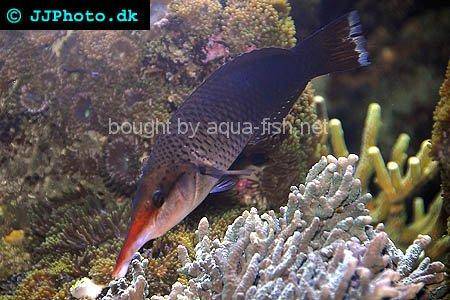
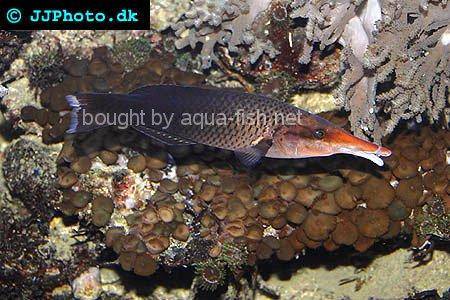
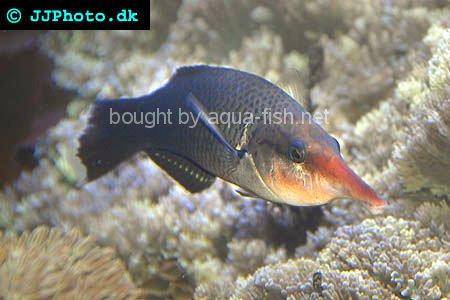
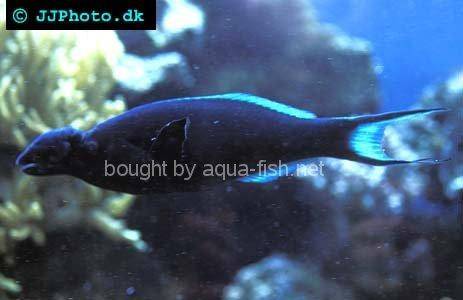
Click on the image below for larger version.
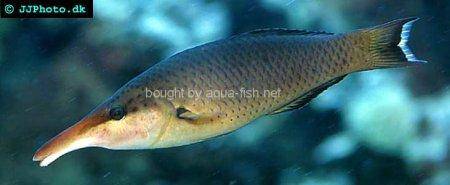
Thanks to Kenneth Leonard for the pictures. Copyright Ken Leonard.
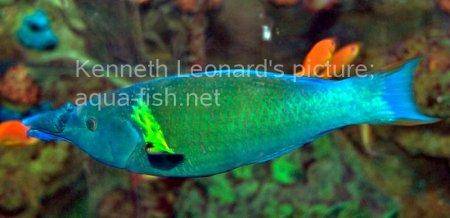
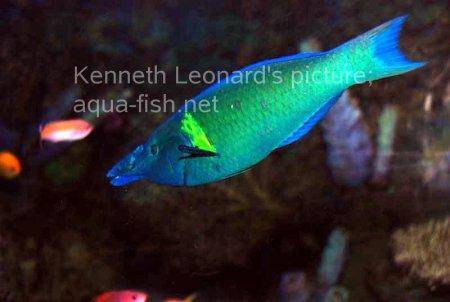
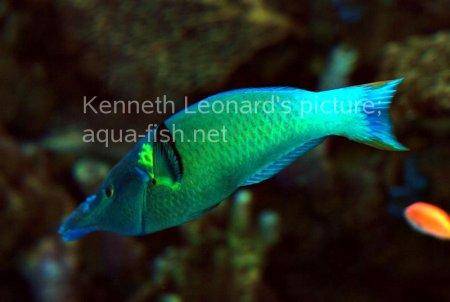
Related fish profiles in the database
Feel free to share your experiences regarding keeping Gomphosus varius below. Every message will be held for approval by our moderators. It usually takes 24 hours to publish your comment. Before you ask anything, browse the questions page, please.
Character and suggestions regarding care
This is a semi-aggressive Wrasse.Brown Bird Wrasse can grow up to 23 cm what is approximately 9 inches. 1 specimen basically needs at least 2760cm2 of water surface which is approximately 427 square inch. This fish should be kept in aquariums that are large. (e) Medium aquariums have at least 113 Litres (30 US Gallons). Large aquariums have at least 265 Litres (70 US Gallons). Capacity of very large aquariums is at least 700 Litres (185 US Gallons).
It is not very difficult to keep the Brown Bird Wrasse fish. (e) The specific gravity (SG) should be between 1,020 and 1,025, the temperature between 23°C (73.4°F) and 26°C (78.8°F). The recommended pH level is between 8.0 and 8.3 since marine fish are used to these levels in general.




Click on the image below for larger version.

Thanks to Kenneth Leonard for the pictures. Copyright Ken Leonard.



Related fish profiles in the database
- Bodianus Anthioides (Lyretail Hogfish, Forktail Hogfish)
- Bodianus Bimaculatus (Twinspot Hogfish)
- Bodianus Diana (Red Diana Hogfish, Diana’s Hogfish)
- Bodianus Pulchellus (Cuban Hogfish, Spotfin Hogfish)
- Bodianus Rufus (Spanish Hogfish)
- Cheilinus Chlorourus (Floral Wrasse)
- Cheilinus Lunulatus (Broomtail Wrasse)
- Cheilinus Undulatus (Humphead Wrasse)
- Cheilio Inermis (Cigar Wrasse)
- Choerodon Azurio (Scarbreast Tuskfish)
- Choerodon Fasciatus (Harlequin Tuskfish)
- Cirrhilabrus Cyanopleura (Blue Head Fairy Wrasse)
- Cirrhilabrus Exquisitus (Exquisite Wrasse)
- Cirrhilabrus Rubrisquamis (Red Velvet Wrasse)
- Cirrhilabrus Rubriventralis (Red Parrot Fairy Wrasse, Social Wrasse)
- Cirrhilabrus Solorensis (Painted Fairy Wrasse, Rainbow Fairy Wrasse)
- Coris Aygula (Clown Coris)
- Coris Formosa (Queen Coris)
- Coris Frerei (Formosa Wrasse, Queen Coris)
- Coris Gaimard (Yellowtail Coris)
- Coris Julis (Mediterranean Rainbow Wrasse)
- Epibulus Insidiator (Slingjaw Wrasse)
- Gomphosus Caeruleus (Green Birdmouth Wrasse)
- Halichoeres Chloropterus (Green Wrasse)
- Halichoeres Chrysus (Golden Coris Wrasse)
- Halichoeres Cyanocephalus (Lighting Wrasse)
- Halichoeres Hortulanus (Checkerboard Wrasse)
- Halichoeres Iridis (Radiant Wrasse)
- Halichoeres Leucoxanthus (Whitebelly Wrasse)
- Halichoeres Maculipinna (Clown Wrasse)
- Halichoeres Marginatus (Dusky Wrasse)
- Halichoeres Melanurus (Tail-Pot Wrasse)
- Halichoeres Poecilopterus (Wrasse)
- Halichoeres Scapularis (Zigzag Wrasse)
- Hemigymnus Fasciatus (Five Banded Wrasse, Barred Thicklip)
- Hemigymnus Melapterus (Blackeye Thicklip)
- Hologymnosus Annulatus (Ring wrasse)
- Labroides Bicolor (Bicolor Cleaner Wrasse)
- Labroides Dimidiatus (Bluestreak Cleaner Wrasse)
- Larabicus Quadrilineatus (Fourline Wrasse, Four Line Cleaner Wrasse, Red Sea Cleaner Wrasse)
- Macropharyngodon Negrosensis (Yellowspotted Wrasse)
- Novaculichthys Taeniourus (Rockmover Wrasse)
- Oxycheilinus Mentalis (Mental Wrasse)
- Paracheilinus Lineopunctatus (Spot-Lined Flasher)
- Pseudocheilinus Hexataenia (Six Line Wrasse)
- Pseudojuloides Erythrops (Redeye Wrasse)
- Stethojulis Trilineata (Three-Lined Rainbowfish, Blue-Ribbon Wrasse)
- Symphodus Tinca (East Atlantic Peacock Wrasse)
- Thalassoma Duperrey (Saddle Wrasse)
- Thalassoma Hardwicke (Sixbar Wrasse)
- Thalassoma Lucasanum (Cortez Rainbow Wrasse)
- Thalassoma Lunare (Moon Wrasse)
- Thalassoma Pavo (Ornate Wrasse)
- Thalassoma Rueppellii (Klunzinger’s Wrasse)
- Saltwater aquarium heater
- Saltwater aquarium lights
- Saltwater aquarium filters
- Saltwater tank aeration
- Marine fish diseases
- Protein Simmers in the Saltwater Tank
- Setting up a Saltwater Tank
- Saltwater Fish Tanks
- Cleaner Shrimp
- Pajama Cardinals
- Banded Butterflyfish
- Black-Ray Goby
- Blue-Banded Goby
- Blue Chromis
- Blue Green Chromis
- Blue Spot Butterflyfish
- Breeding Seahorses
- Cleaning Goby
- Common Seahorse
- Domino Damselfish
- Dragonface Pipefish
- Drawf Seahorse
- Fire Goby
- Ghost Pipefish
- Golden Damselfish
- Humbug Damselfish
- Lemonpeel Dwarf Angelfish (Centropyge flavissima) Care
- Longfin Bannerfish
- Majestic Angelfish Care
- Neon Velvet Damselfish
- Northern Seahorse
- Pyramid Butterflyfish
- Spotted Watchman Goby
- Tips on Yellow Longnose Butterflyfish Care
- Two Spot Goby
- Yellow Longnose Butterflyfish
Feel free to share your experiences regarding keeping Gomphosus varius below. Every message will be held for approval by our moderators. It usually takes 24 hours to publish your comment. Before you ask anything, browse the questions page, please.
Document modified on Sat Sep 27 1:30:04 UTC 2008
Document created on Tue Dec 11 11:16:57 UTC 2007
How to cite this page? Use the following HTML:
edit this page or create a new fish profile "Brown Bird Wrasse." saltwater.aqua-fish.net. Tue Dec 11 11:16:57 UTC 2007.
Aqua-Fish.Net. Sat Jul 19 0:09:08 UTC 2025 https://saltwater.aqua-fish.net/?brown-bird-wrasse.